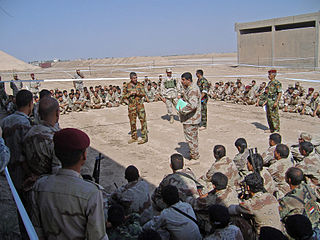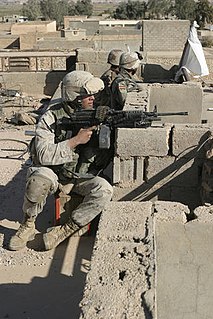
The 2nd Infantry Division is a formation of the United States Army. Its current primary mission is the pre-emptive defense of South Korea in the event of an invasion from North Korea. There are approximately 17,000 soldiers in the 2nd Infantry Division, with 10,000 of them stationed in South Korea, accounting for about 35% of the United States Forces Korea personnel.

The 1st Infantry Division is a combined arms division of the United States Army, and is the oldest continuously serving division in the Regular Army. It has seen continuous service since its organization in 1917 during World War I. It was officially nicknamed "The Big Red One" after its shoulder patch and is also nicknamed "The Fighting First." The division has also received troop monikers of "The Big Dead One" and "The Bloody First" as puns on the respective officially sanctioned nicknames. It is currently based at Fort Riley, Kansas.

The ICV Stryker is a family of eight-wheeled armored fighting vehicles derived from the Canadian LAV III. Stryker vehicles are produced by General Dynamics Land Systems for the United States Army. It has four-wheel drive (8×4) and can be switched to all-wheel drive (8×8).

The 4th Infantry Division is a division of the United States Army based at Fort Carson, Colorado. It is composed of a division headquarters battalion, three brigade combat teams, a combat aviation brigade, a division sustainment brigade, and a division artillery.
Soldiers from the U.S. 1st Armored Division's 3rd Brigade Combat Team struck at insurgent elements in the Al Mansor district on the west side of Baghdad on 7 December 2003, according to U.S. Central Command officials.

The 4th Brigade, 2nd Infantry Division ("Raiders") is an inactive Stryker Brigade Combat Team (SBCT) of the United States Army. The brigade was activated at Fort Lewis, Washington on 1 June 2006 by reflagging the 2nd Stryker Cavalry Regiment. The 4th Stryker Brigade had the distinction of being the last U.S. Army combat brigade to serve in support of Operation Iraqi Freedom. The brigade deployed three times in support of the War on Terror, to Iraq from 2007–2008 and from 2009–2010, and to Afghanistan from 2012–2013 before inactivating in March 2014.
Operation River Falcon was a military operation in the Iraq War. From 25–27 July 2006, elements of the United States Army 2nd Brigade Combat Team, 4th Infantry Division conducted Operation River Falcon in and around the town of Sayifiyeh in Iraq. The operation was aimed at denying terrorists the use of the town as a safe haven, disrupting insurgent attacks on Coalition and Iraqi Army/Police, and on collecting and destroying insurgent munitions.
Operation Black Eagle is an operation that took place during Operation Iraqi Freedom from 2003 to 2010. It was the 381st listed operation during the Iraq war in 2003 Black Eagle was an operation in which U.S. Polish, and Iraqi troops battled gunmen loyal to anti-American cleric Muqtada al-Sadr in the town of Al Diwaniyah, which is the capital of Iraq's Al-Qādisiyyah Governorate, for control of the city. U.S. warplanes targeted insurgent positions with Hellfire missiles in and near the city. As of 7 April 2007, Iraqi officials have verified six insurgents killed and 39 captured. On 10 April 2007, combat operations had been declared to have ended and the operation continued into the reconstruction phase. There is no relation to Operation Black Eagle II that took place in January 2007.
Operation Warrior's Rage was a United States and Iraqi Army cordon-and-search operation during the US occupation of Iraq. The operation was performed on the evening of 15 July 2005.
Operation Ardennes was part of the Iraq War.
The Battle of Baqubah II took place during the Iraq War in the capital of the Iraqi province Diyala, to the north-east of Baghdad. It began in early March 2007, when US and Iraqi forces commenced preliminary operations to "establish a presence in Diyala beyond their Forward Operating Base".

Operation Phantom Thunder began on 16 June 2007, when Multi-National Force-Iraq launched major offensive operations against al-Qaeda and other extremist terrorists operating throughout Iraq. Operation Phantom Thunder was a corps level operation, including Operation Arrowhead Ripper in Diyala Province, Operation Marne Torch and Operation Commando Eagle in Babil Province, Operation Fardh al-Qanoon in Baghdad, Operation Alljah in Anbar Province, and continuing special forces actions against the Mahdi Army in southern Iraq and against Al-Qaeda leadership throughout the country. The operation was one of the biggest military operations in Iraq since the U.S. invasion in 2003.

Operation Commando Eagle was a 2007 military operation of the Iraq War. It began on 21 June 2007, when Iraqi and Coalition forces launched a combined ground and air assault operation against al-Qaeda and other extremist terrorists operating in the Mahmudiyah region of Babil province. The action was intended to curb terrorist activity southwest of Baghdad through a mix of helicopter assaults and Humvee-mounted movements.
Iraqi and U.S. Soldiers nabbed 46 men suspected of involvement with the al Qaeda network 12 July 2007 under the cover of darkness, east of Lutifiyah, Iraq.
Without a single shot being fired, more than 3,000 members of the Iraqi Security Forces (ISF) and Bastogne Soldiers from the 1st Brigade Combat Team, 101st Airborne Division, detained 154 terror suspects and seized more than 350 semi-automatic and automatic rifles, a variety of pistols and mortar rounds, as well as a large number of materials used to make Improvised Explosive Devices (IED) during Operation Gaugamela (gaw'guh-MEE-luh), a search for suspected al-Qaeda terrorists in the cities and areas surrounding Hawija and Riyadh, just west of Kirkuk, Iraq.

Operation Phantom Strike was a major offensive launched by the Multi-National Corps - Iraq on 15 August 2007 in a crackdown to disrupt both the al-Qaeda-affiliated Islamic State of Iraq and Shia insurgent operations in Iraq. It consisted of a number of simultaneous operations throughout Iraq focused on pursuing remaining ISI terrorists and Iranian-supported insurgent groups. It was concluded in January 2008 and followed up with Operation Phantom Phoenix.

The 20th Infantry Regiment is a United States Army infantry regiment. Currently only the 5th Battalion of the 20th Infantry still exists. Stationed at Joint Base Lewis-McChord and part of the 1st Stryker Brigade Combat Team, 2nd Infantry Division, 5-20 Infantry was one of the original battalions selected to take part in the testing and fielding of the Army's new Stryker vehicle.
Operation Phantom Phoenix was a major nationwide offensive launched by the Multinational Force Iraq (MNF-I) on 8 January 2008 in an attempt to build on the success of the two previous corps-level operations, Operation Phantom Thunder and Operation Phantom Strike and further reduce violence and secure Iraq's population, particularly in the capital Baghdad. The offensive consisted of a number of joint Coalition and Iraqi Army operations throughout northern Iraq as well as in the southern Baghdad Belts.

The 52nd Infantry Regiment is an infantry regiment of the United States Army.

Operation Sayeed also known as Operation Hunter in English, was a series of operations conducted in western Al Anbar Governorate by the United States Marine Corps in 2005. It was an umbrella operation, consisting of at least 11 named operations between July 2005 to December 2005. The purpose was to drive Al-Qaeda in Iraq forces from the Western Euphrates River Valley. Some parts of Operation Sayeed were Operation Steel Curtain and Operation Iron Fist.










